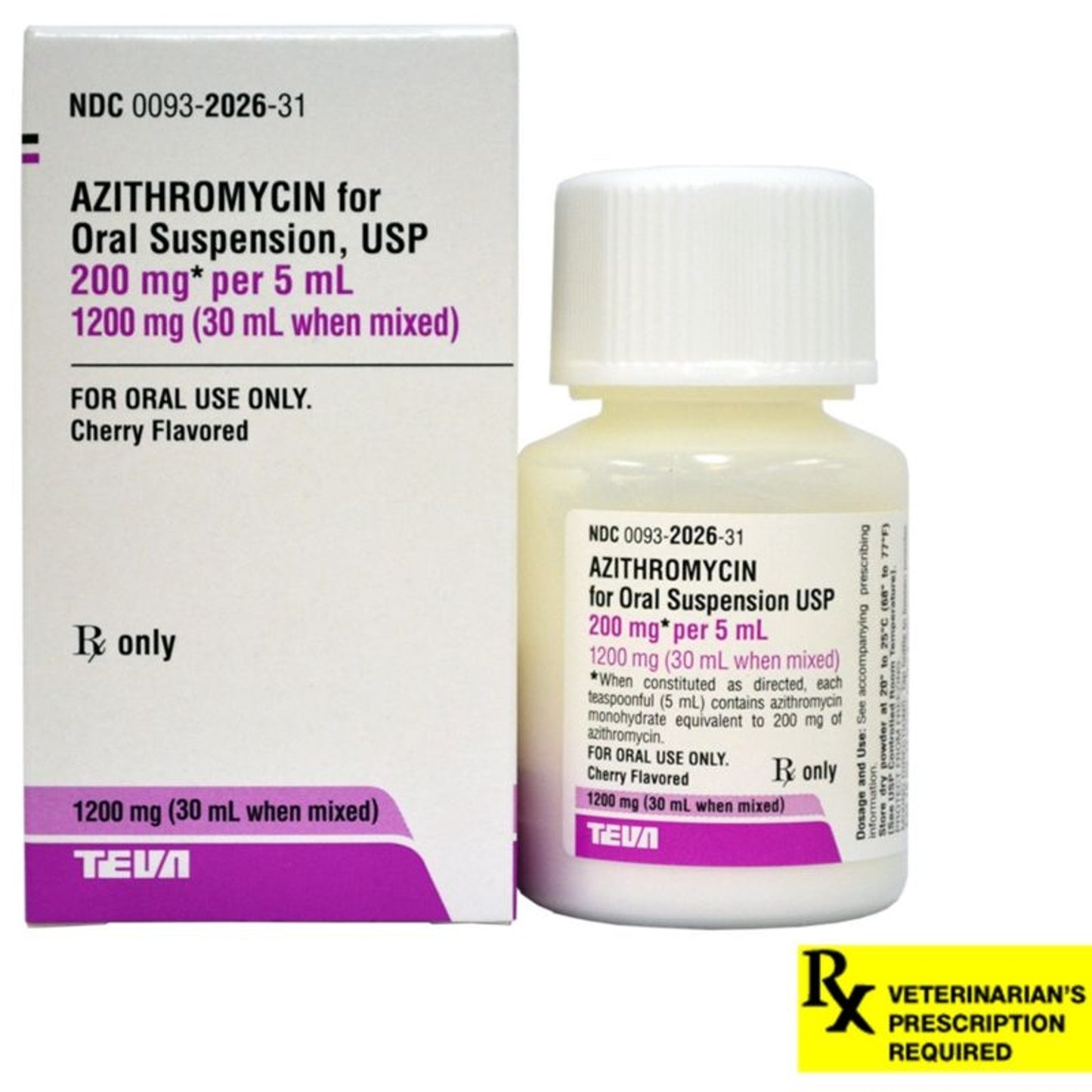1
/
of
1
Zithromax
Azithromycin 200mg/5ml Suspension 30ml
Azithromycin 200mg/5ml Suspension 30ml
Regular price
$27.24
Regular price
$27.24
Sale price
$27.24
Unit price
/
per
Sale
Sold out
Couldn't load pickup availability
Usually Ships in 1-2 business days
Oversize Fee: $0.00
This item not eligible for additional promotional discounts.
SKU:PX101008
Overview of Azithromycin for Canines and Felines
Azithromycin, better known as Zithromax® and commonly as the "Z-pack" in humans, is used for dogs and cats to treat dermatological infections, respiratory tract infections and urogenital infections.
Azithromycin, derived from erythromycin, belongs to the azalide subclass of macrolide antibiotics . Like other macrolide antibiotics, it works by binding to the "P" site of the 50S ribosomal subunit of susceptible microorganisms interrupting RNA-dependent protein synthesis.
Susceptible bacteria include: Staphylococcus aureus, various Streptococci, some Hemophilus spp, certain Bacteroides spp, Borrelia burgdorferi, some Mycoplasma spp, and some species of Chlamydia.
Following oral administration, azithromycin is rapidly absorbed and widely distributed throughout the body. Azithromycin's bioavailability is 97% in dogs, 58% in cats, and its protein binding is 7-51%, depending on the plasma concentration.
Rapid distribution of azithromycin into tissues results in significantly higher azithromycin levels in tissues than in plasma. The half-life of azithromycin is long. The tissue half-life in dogs may be up to 90 hours. In cats tissue the half-life is 13 to 72 hours, depending on the tissue. Azithromycin undergoes some hepatic metabolism but the majority of an administered dose is excreted unchanged in bile.
Azithromycin is a prescription drug and can only be obtained from a veterinarian or by prescription from a veterinarian.
This drug is not approved for use in animals by the Food and Drug Administration but it is prescribed legally by veterinarians as an extra-label drug.
Uses of Azithromycin for Dogs and Cats
Treatment of infections caused by susceptible microorganisms:
Dermatological infections
Respiratory tract infections
Urogenital infections
Otitis media
Precautions and Side Effects
Azithromycin should not be used in animals with known hypersensitivity or allergy to it or other macrolide antibiotics. In addition, it should be used with great caution (if at all) when there is preexisting liver disease. Gastrointestinal side effects may include vomiting, diarrhea, or abdominal pain. Angioedema and cholestatic jaundice have been reported (rarely) in treated humans. Cardiac arrhythmias, including ventricular tachycardia, may be precipitated by azithromycin. Renal dysfunction, including interstitial nephritis and acute renal failure, may occur secondary to azithromycin treatment and liver function may be affected.
Drug Interactions
Azithromycin may elevate serum digoxin levels. When ergotamine or dihydroergotamine are concurrently administered with azithromycin ergot toxicity may occur. Azithromycin causes a decrease in the clearance of triazolam and thus an increase in its pharmacologic effects. Pimozide is contraindicated in patients receiving azithromycin, and vice versa (death may result). Animals being treated with cisapride should not be given azithromycin or other macrolide antibiotic . Drugs metabolized by cytochrome P450 (e.g. carbamazepine, terfenadine, cyclosporine, hexobarbital, and phenytoin) will have their serum levels elevated by azithromycin. Oral antacids reduce the absorption of azithromycin.
How Azithromycin is Supplied
Tablets: 250 mg, 500 mg, 600 mg
Powder for injection: 500 mg (lyophilized) in 10 mL vials
Powder for oral suspension: 100 mg/5 mL, 200 mg/5mL, & 1 g/packet
Dosing Information of Azithromycin for Dogs and Cats
Medication should never be administered without first consulting your veterinarian. In dogs, the usual dosage is 2.5 to 5 mg per pound (5 to 10 mg/kg) orally once daily for up to 7 days. In cats, the usual dosage is 2.5 to 7.5 mg per pound (5 to 15 mg/kg) orally every 12 to 24 hours for up to 7 days. The duration of administration depends on the condition being treated, response to the medication and the development of any adverse effects. Be certain to complete the prescription unless specifically directed by your veterinarian. Even if your pet feels better, the entire treatment plan should be completed to prevent relapse.
Model Numbers and UPCs
Model Numbers and UPCs
| Style | Item Number | UPC |
|---|---|---|
| One Size | PX101008 | 300932026315 |
Share


